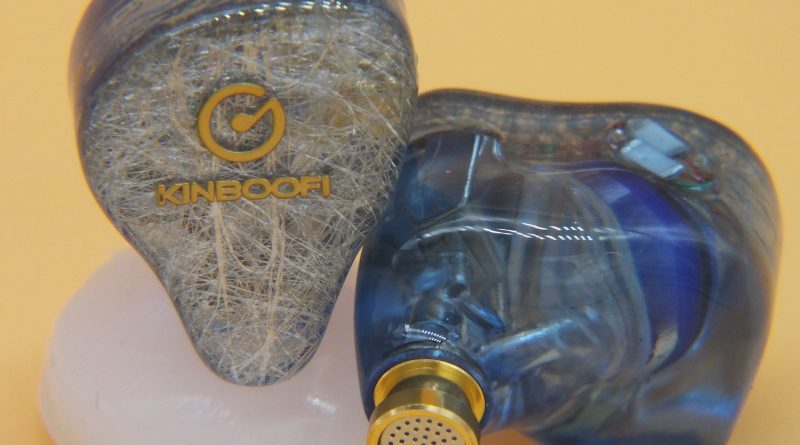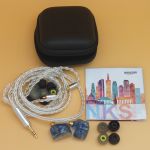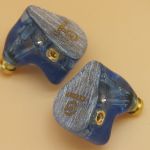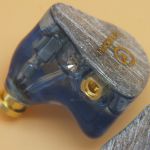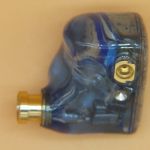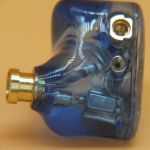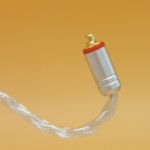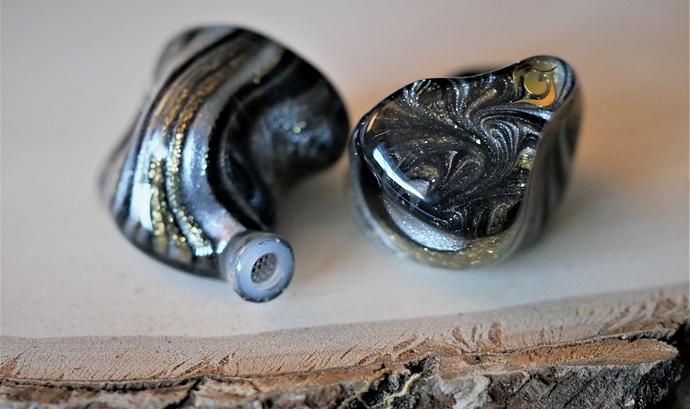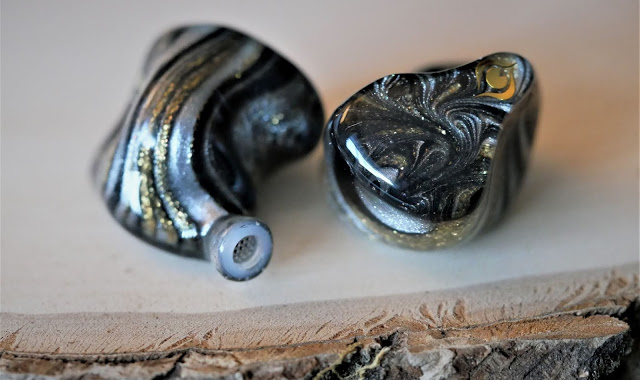I have not heard anything by Moondrop yet.
2 posts were merged into an existing topic: BGVP Studio Products
Kinboofi Mx3
disclaimer: I was provided the Mx3 by Kinboofi (via their Amazon Store) in exchange for reviewing it. I have no financial interest in either Kinboofi or Amazon. arrived 6/22
Unboxing / Accessories:
The Mx3 comes packed in a blue leather(?) box similar to what the older generation will remember as a watch box. The lead edge of the box tilts back and is hinged with a snap-open/closed mechanism to hold the box open. Inside the box is a small square clam shell style case and the warranty card. All other items are hiding inside the clam shell. A foam insert with a cutout for the clam shell would be a welcomed improvement as it would improve the aesthetic of the packaging if little else. Inside the case, we find the cable, earpieces, and 6 sets of tips. The cable and earpieces are individually bagged to prevent scratches and each type of tips is bagged separately. Tips provided are 3 sizes of black silicone star type tips and 3 sizes of spin-fit style tips with green center cores and translucent domes. No explanation of the tips is provided, but my observations were the black are a bit more bass oriented while the clear are a bit more balanced.
Build/Fit:
Ok, so yes these are a looker. Shells are acrylic with what appears to be polished steel wool in the face plates and a medium blue transparent body. The most distinct feature of the Mx3 is the stainless vent immediately in front of the mmcx ports. When illuminated one can trace the tubing from the back of the vent to the rear of the dynamic driver. This means the shell can be poured acrylic and solid rather than hollow as is more common with dynamic driver models and hybrids. Size wise, these are on the larger side and are similar to the Fiio FH5 or Kinera Idun in both shape and overall dimensions. Nozzles centered at the lower end of the shell with no rake to speak of and allow for fairly deep insertion. Isolation is fairly good as a result. Nozzles do have a lip for tip retention as well. MMCX connectors are mounted cleanly with no visible gaps or glue. These appear to be a handmade and polished shell which is quite an accomplishment at the $135 price being asked.
Internals:
The MX3 is a hybrid design using a 10mm dynamic driver paired with 2 BA drivers. The BA drivers consist of a Knowles ED29689 handling the mids and a Belssing 30095 handling the high end. Details about the Dynamic driver are a bit harder to find. The dynamic is set up with a vent immediately in front of the MMCX connector and a sound bore from the front to the nozzles so unlike many which utilize the chamber, the dynamic driver is completely enclosed in this design. Measured impedance was 21Ω with a sensitivity of 116dB\mW (+/- 3db between 200hz-12kHz). I found the Mx3 easy to drive, but better with a bit of extra power as the coherency suffers when not powered adequately.
Cable:
The cable provided with the Mx3 is a 6 line braid below the splitter and a 3 wire braid above. Fixtures are a straight 3.5mm jack with a polished aluminum case, a brushed aluminum splitter, and a clear bead chin slider, followed by brushed aluminum mmcx connectors with pre-formed hooks. MMCx are marked for L/R with the standard red ring on the right side. The cable shows good pliability with little microphonics. I had no issue with the earpieces shifting once in place due to cable pressure so use running or in the gym is quite possible.
Sound:
Bass:
Sub-bass has good rumble and authority. Mid-bass follows with equal thump, but not particularly ahead of the rest of the signature. Attack speed is good with just slightly slower decay that leaves some warmth in its wake. Bass texture is well done and I found little if any tendency to get thick as tracks got more complex. Its a dynamic driver bass doing a good job of mimicking a BA bass. Tight, and clean, but without a lot of sub-bass. I do think it delivers a bit more warmth than a typical BA bass and departs from that comparison in that way.
Mids:
The transition from mid-bass to lower-mids is clean and smooth without notable bleed or obstruction of the lower-mids. Thankfully, there is no dip in the lower-mids as is so common today. They are near linear from the mid-bass and the detail level of the lower mids is quite good. I have to remind myself that this is still arguably a budget model as its mids are competitive with things I’ve paid considerably more for. Texture of the mid-range is better than expected and as such the growl of electric guitars (Lenny Kravitz anyone?) is satisfyingly realistic. Upper-mids push forward and do emphasize the vocal range well with upper range vocals cutting through a bit more than lower counterparts. Bass and baritone vocals are inline with guitars and lower instrumentation while anything tenor and up starts pushing a bit more forward in the mix. The push is well done and isn’t a ball of spikes as some are but more of gentle curve that is difficult to establish the exact boundaries of.
Treble:
While I am beginning to think I could write about the treble of the Belssing 30095 in my sleep due to its popularity, I have to admit this is one of the cleaner implementations I have heard and lacks the grain and big peaks and valleys often associated with it. Lower treble is elevated but not jagged or harsh, there is a drop off above that and then a bump around 9k that brings some air to the top end. Final roll-off becomes perceptible quickly above the 11kHz mark. Overall, a very pleasant treble with enough energy to feel lifelike without getting strident or harsh. Cymbals are reasonably well executed and believable.
Soundstage / Imaging:
Soundstage is a bit wider than deep, and does give some sense of height. I would define the sound stage as smaller theater size rather than cavernous. Instrument separation is quite good and seating the orchestra by listening puts pretty much all in the correct place. Spatial cues are well handled so movement around the stage is very precisely rendered. Layering was quite good as well with complex passages being well rendered. The Mx3 did not have any trouble with more complex tracks and didn’t seem to get dirtier as track complexity scaled upward.
Comparisons:
I have tried to compare to models at roughly the same price point. I am not going to go into build comparisons as all are well made.
ikko OH1 – Both have similar tunings with the major differences being the sub-bass digs deeper on the OH-1, and the Mx3 has a cleaner treble and handles complex tracks a bit better. Those looking for more bass will appreciate the OH1 while those looking for something a bit closer to neutral will like hte Mx3.
Simgot EN700Pro – The 700pro is a good bit more V shaped than the Mx3 and struggles as volume increases. While I like the 700pro at lower volumes, it is hard to compare it here as it simply cannot be driven hard without introducing considerable distortion.
Fiio F9 Pro – Way more V shaped and nowhere need as detailed in the mids, the kit on the Fiio is way better, but the sound on the Mx3 easily distances itself from the F9 Pro.
Kinera Idun – These two are more similar than not. Both have good bass control, but will not satisfy the basshead crowd. To me, the Mx3 is a bit better on lower mids, while the idun is a bit closer to neutral in the upper-mids and lower treble. those who prefer a bit brighter signature will opt for the Mx3 while the treble shy may prefer the Idun.
ToneKing 9-tails – regardless of which filter I used, the 9-tail is more of a V than the Mx3. Bass is a bit heavier hitting on the 9 tail, but speed and texture is a bit better on the Mx3. Mids have more detail on the Mx3 while treble is slightly more detailed on the 9-tail. Fit can be an issue with the 9 tail, while the Mx3 is a bit more of a conventional design.
BGVP DMG – The DMG with its stock filter set digs deeper in the bass than the Mx3 but is not nearly as clean as decay is a bit slower and comes across as a bit loose when compared to the Mx3. Mid detail is good on both, but timbre and texture are a bit more realistic on the Mx3. Treble is a bit more forward on the DMG and both roll-off at roughly the same point.
Thoughts / Conclusion:
The Mx3 is extremely well made especially considering this is a handmade shell at an asking price of less than $150 USD. I am impressed with the venting system utilized and hope it becomes more common as it removes variables associated with materials when the shell is used rather than using a tubed vent like the Mx3. (The Magaosi DQ4 shares a lot of design similarities with the Mx3 and also uses this sound bore vent dynamic driver design.
Sound wise, Kinboofi is obviously coming of age as each successive product has a bit more coherent and mature tuning. I was impressed with the Mk4 and the Mx3 may be a bit better with respect to coherency if not detail where the Mk4 still has the advantage. The Mx3 shows good linearity with a push in the upper-mids/lower treble that brings vocals to the forefront and adds a bit of vibrancy to the mix.
Having recently auditioned the Mk4 and now the Mx3, I now believe that Kinboofi is a highly underrated brand in the mid-fi space. Both of these two models are very cost competitive and deliver excellent sound for the asking prices. Those who are more familiar with the <$40 models are not seeing what Kinboofi is really capable of. Having reviewed a few models in the lower space, they do not do the brand justice and Kinfboofi should really consider splitting the higher-end models into their own sub-brand to differentiate them from the lower end products.
SOUND QUALITY
6.9/10
- Bass - 7/10
- Mids - 7/10
- Treble - 7/10
- Soundstage - 6.5/10
- Imaging - 7/10
Summary
Pros: Fantastic build quality and better than average sound quality.
Cons: packaging and kit are more pedestrian than other offerings at this price point.
The shell pattern on that looks a lot like the Fearless S6 Rui and the qdc Anole VX… that …I … may… have … just ordered…
Looks quite a lot like the Magaosi DQ4 but I’m told they are no relation.
You ordered the Anole VX??? Looking forward to your thoughts…
Yea. It started with something constant badgering on crinacle’s discord, then @MCM going to canjam and immediately loving them and letting me know (since we both have equally same tastes in gear and music) and then a random Reddit thread where @jrockwell set me up to meet with a local Anole VX owner and within about a minute of listening, I was sold.
And then when I got home I ordered it within an hour.
I happened to be in a vulnerable position of having recurring fit issues with Solaris. 
Awesome! Hope you love them! 
On that note, what do you think of qdc as a brand? Tempted to pick up a fusion but I really don’t trust stuff that come from 深圳, would I be better off with a Fearless ACME or FH7/ Moondeop A8/ BGVP Art magic? (My grandpa lives near Fearless’s HQ in 鞍山 so it would be cheaper to get).
This would be my first experience with qdc, but you can buy it from musicteck in the US. The brand makes quality products from what I’ve been told by the online community, especially those in the Singapore and southeast Asia where the iems are very popular and very accessible for demoing.
Many of them rate qdc brand iems quite highly. The fusion was on my radar as a Solaris replacement but some folks I tend to trust said it wasn’t as good in a few technical areas as the Solaris, while still being a good IEM.
The Gemini and Anole VX are very well liked but also the most expensive.
Oh, of your list I haven’t listened to any of them but the Moondrop A8 was on my list as well as the Fearless S6 Pro
5 posts were merged into an existing topic: Knowledge Zenith (KZ), CCA, Tripowin and Associated Brands Discussion
Hi all, thanks all for the warm welcome.
I bought 2 IEMs at the recent Summer Aliexpress Sale - one was the KZ ZS10 Pro as reviewed above, and the second one was the TFZ No. 3 (regular).
I read many good things about these 2 CHIFI IEMs, so I wanted to give them a try.
I think I will have to survive on scraps for the next few weeks as my wallet is totally empty haha.
This is my TFZ No. 3 review, not sure if there is a TFZ thread in this forum?
Out of the box, my initial impressions of the TFZ No. 3 were not very favourable, I found the bass over boomy and the mids recessed, with some harsh treble, but having burnt it in and listened more extensively, I am really really loving this IEM. So in the future, I have learnt not to make any firm impressions of any audio gear till more extensive listening. Just a few months ago, I was not a believer in burn in, but I am surprised that my initial impressions out of the box was so different after a week of listening. Not sure if it is a psychological brain burn in or there was some true mechanical difference in the equipment with use?
I have a few other CHIFI IEMs that are multi BA or hybrids, and I was wondering how a single DD driver IEM like the TFZ No. 3 can compete with these. So as it turns out, tuning is the more important aspect than the number of drivers. And the TFZ No. 3 is very beautifully and vividly tuned. It has a non fatiguing, warm and slightly dark signature that I can listen to for hours.
Build:
It is made of plastic, but is extremely light.
The stock cable is detachable and quite thick and of good quality with no microphonics. I tried a few different cables, such as the NICEHCK 8 braided cable, but decided to stick with the stock one in the end, due to the sound signature and fit. The stock cable has no chin clinch though.
It comes with many stock tips and after tip rolling a bit, I still found the stock ones to still suit me better.
Isolation/comfort:
These are one of the most comfortable IEMs I have ever used. I can wear it for hours with no issues. It is extremely light and ergonomic.
The isolation is also excellent. I have used it in the subway or crowded areas with good isolation.
Sound:
This IEM is easily drivable from smart phones, and doesn’t really need any amping. I have tested it so far with a HD Sonata and Fiio A3.
My initial impressions was that this was a V shaped tuning, but after extensive listening, it is more of a U shape, with mildly recessed lower mids (and boosted bass and slightly boosted lower treble/higher mids).
Bass:
Excellent bass (midbass and subbass) that is well textured, clear yet well controlled and detailed. The timbre is spot on and has quite fast response. It has no midbass bleed IMHO. The bass is the most emphasized of the entire frequency spectrum, but I never found it overpowering other frequencies so far. I am not a basshead by any means, but of the IEMs I own, these are one of the most bassiest ones, but I won’t quantify this IEM as a basshead IEM. The bass is definitely my most favourite aspect of this IEM.
Mids:
It has slightly recessed lower mids, but a boost in the higher mids. As such, male voices sound softer than female ones to me. Vocals and instrument tonality/timbre is superb and make me feel like I am listening to singing from the first row of a stage.
Resolution is good, but this IEM may not suit those who want a analytical signature for critical listening. Most of the details in the music can still be heard, but IMHO as a single DD Driver, it loses out to some other multi BA drivers in resolution.
Treble:
Lower treble is slightly boosted. Overall it is non fatiguing, with no silibance and very airy. There is a slight roll off in the higher frequencies, so maybe treble heads may not appreciate it. But nevertheless, most of the details are there and I can listen to the IEM for hours without fatigue. I never found the treble vocals harsh or shouty either.
Soundstage:
Above average as per most IEMs compared to open backed headphones.
Conclusions:
I initially wasn’t impressed with TFZ No.3 out of the box, but after listening for almost a week, it has steadily grown on me and I love it now. The excellent bass, great warm tonality, non fatiguing highs, and comfortable fit, can let me listen to it for hours.
Definitely at its price point of about $100, I would recommend it to anyone who wants a warm, non fatiguing, vivid signature. I would say this is not the IEM for those who prefer critical listening and an analytical signature.
I have not listened to the Kansas Moondrop Pro, but it seems for a single DD IEM, the Kansas Pro is the main competitor for the TFZ No. 3. So maybe some of you guys can enlighten me if you have the Kansas Pro?
I’ll still be using the ZS10 Pro as my daily driver, but the TFZ No. 3 has a totally more warm and laid back signature that is more suited for chilling and relaxing.
Nice review.
Peacock P1
They look better than they sound unfortunately. This is a V-Shaped IEM that is a tad bright.
Highly calibrated Measurements (analog)
Digital Measurements
First Impressions
Peacock P1
General
- Beautiful and stunning design.
- Great fit, and packed with accessories.
- Comes with a bluetooth cable!
Sound
- Big punchy bass, a little smeared
- Mids are lacking detail
- Treble is a little harsh and can be pretty bright
- V-Shaped Sound Signature
- A little generic sounding, but more detailed than brick & mortar store headphones
@TylersEclectic I’m just going to put this here: https://www.aliexpress.com/item/33057691771.html?spm=a2g0s.9042311.0.0.4f0c4c4dfdrP6x
Ooh, lavender purple!
Ordered lol
PEACOCK P1
Peacock Audio: Who are they? Where did they come from? Never heard of them and I couldn’t find any information on them besides the Linsoul.com listing for their new P1 in-ear monitor earphone. This single dynamic driver earphone is absolutely beautiful though, and these guys must have experience doing work before to make something as detailed and beautiful as how the shells on the P1 look.
This review unit was provided to me by Lillian of Linsoul. If you are interested in purchasing this, please visit the Linsoul Official Store or LSR-Direct on Amazon.com.
When I opened the package, I was greeted with layers and layers of stuff. The first layer had a nice fake leather case, similar to ones I already own. Then the IEMs are present in their beautiful gold, silver and black “peacock” feather design. They look like sand-art, with just great texturing and a look like no other universal IEM I’ve seen yet.
Once you hit the cables and tips, there’s another layer, which includes a Bluetooth cable! That’s a surprise. The cable that comes with the IEM is nice, white and thick. It handles pretty well and looks nice, and matches the aesthetics of the P1.
The shells have a custom-universal type fit but smaller than many of these types of shell designs that have been released recently, such as ones from BGVP, qdc, and others. This smaller shape really fits nicely for a deep, snug fit in my ears and I never felt any discomfort with them.
Sound
The P1 has a gentle V-shape sound signature that doesn’t sound quite as good as they look, but isn’t bad either. There’s boosted bass, a recessed mid-range and a peak in the 8K area that I am sometimes sensitive to, but I didn’t fit these to bother me as much as I normally would, most likely due to the upper-mids being boosted as well.
The P1 bass is elevated. They have quite a bit of rumble, and punch. Bass is presented a little muddy and flabby at times. It’s a little slower than I would like, and the fact that mid-range drops off quite a bit does cause some signs of muddy lower midrange behavior. W
The mid-range does sound a tad flat. The bass brings a lot of warmth, but also recession here, which makes the lower mids and central mid-range area not quite as defined and standing out. There’s a little bit of bloat in the lower-midrange, but I only find it distracting on songs that are bass heavy.
Luckily, the upper mid-range, which I find important, is done well, with a nice smooth curve with upper treble air that presents a decent spacious sound, though I still find this IEM to be rather forward and intimate sounding. It would be very congested if not for the airy treble, which borders on harshness and fatigue.
Some Select Listening
Fleetwood Mac’s The Chain
The very beginning of the track features a little bit of fiddling around and breathing and it’s barely audible on the P1. When the kick drum settles in, it’s the star of the show, standing in front and center, while the guitar string plucks ring in with good precision. I was surprised that the guitar strings in this track didn’t cause my fatiguing, and cymbals seemed well controlled.
The vocals of the band seem a tad more distant than I would prefer, and missing a little bit of it’s magic. When 2:13 rolls around, the drums again, take over the show. At around the 3 minute mark, the bassline has a nice rumble to it, while the snare drum seems well controlled. Once the guitar solo begins, and the track becomes a bit more busy, the P1 doesn’t seem to really struggle too much with this busy passage. There’s just enough distance between instruments and width to keep things from being congested.
Haelos’s Pray
This is a nice electro-rock song with a lot of ambience and bass hits. The P1 is well suited for these heavy bass strikes that crash in throughout the song. Each transition is met with a good amount of rumble and feeling, and drums seemed to be controlled relatively well. On a song like this, the advantage of having the vocals a little further back is that it does not become shouty, which I do find on headphones with a more mid-forward sound.
Mazzy Star’s Flowers in December
This acoustic classic from the early 90’s is one of my favorite songs. While it may seem like a sweet and gentle track, the bass guitar on this song is quite powerful and the P1 may overly emphasize it a bit, as it drowns out Hope Sandoval’s already quiet voice a bit more. That’s unfortunately, because her strained and breathy vocals are so full of raw emotion and feelings that it seems a like a sin to have it buried behind heavy bass notes. The harmonica featured on this song seems slightly muted and missing some of it’s dynamics, however it doesn’t fatigue like it may on some other headphones and earphones.
Comparisons
BGVP DM7
The DM7 is another warm-tuned earphone, but is more balanced in nature. It’s mid-range isn’t as far recessed, nor is it’s bass as elevated. The DM7 does lack a bit of treble extension and air that the P1 has though and may sound intimate and congested in relation to the P1.
BGVP DM6
The DM6 is also V-shaped, but I felt it was beyond my threshold for brightness leading to a very fatiguing and unappetizing listen. It’s very detailed and beats the P1 in that department, and also seems to be a bit faster, due to it’s BA configuration. I find the P1 a much more natural sounding IEM.
Moondrop KXXS
The KXXS shares many similarities in tuning to the P1, however the KXXS is just a tad brighter than I like and I ended up hearing some little bits of edgy brightness. The P1 is also more bass heavy and it’s definitely apparent when A-Bing between the two. This ends up being fatiguing to me. I do like the KXXS’s less bass-heavy presentation however, and picking it as my preferred normal listen.
Conclusion
In the end, I think the P1 is a decent sounding IEM, but I feel like the majority of the money and value goes into the excellent shell design, appearance, and comfort. The sound leaves a bit to be desired for the price tag and this is mostly because I find the tuning not overly exciting, but also doesn’t do anything particularly wrong either. It’s a little more elevated in the bass department than I would like, but it’s not so much that I find obnoxious. The mid-range is a little boring, and that’s very important to me, and that’s most of the reason why I find that the P1 is just missing an X-Factor in terms of sound.
That said however, I find the overall package of this P1 a pretty good investment. It does come in a beautifully designed shell that fits well, a nice carrying case, and the added bonus of Bluetooth cables to swap out for a semi-wireless experience.
They do look pretty, however you rate the sound.
Great review.
